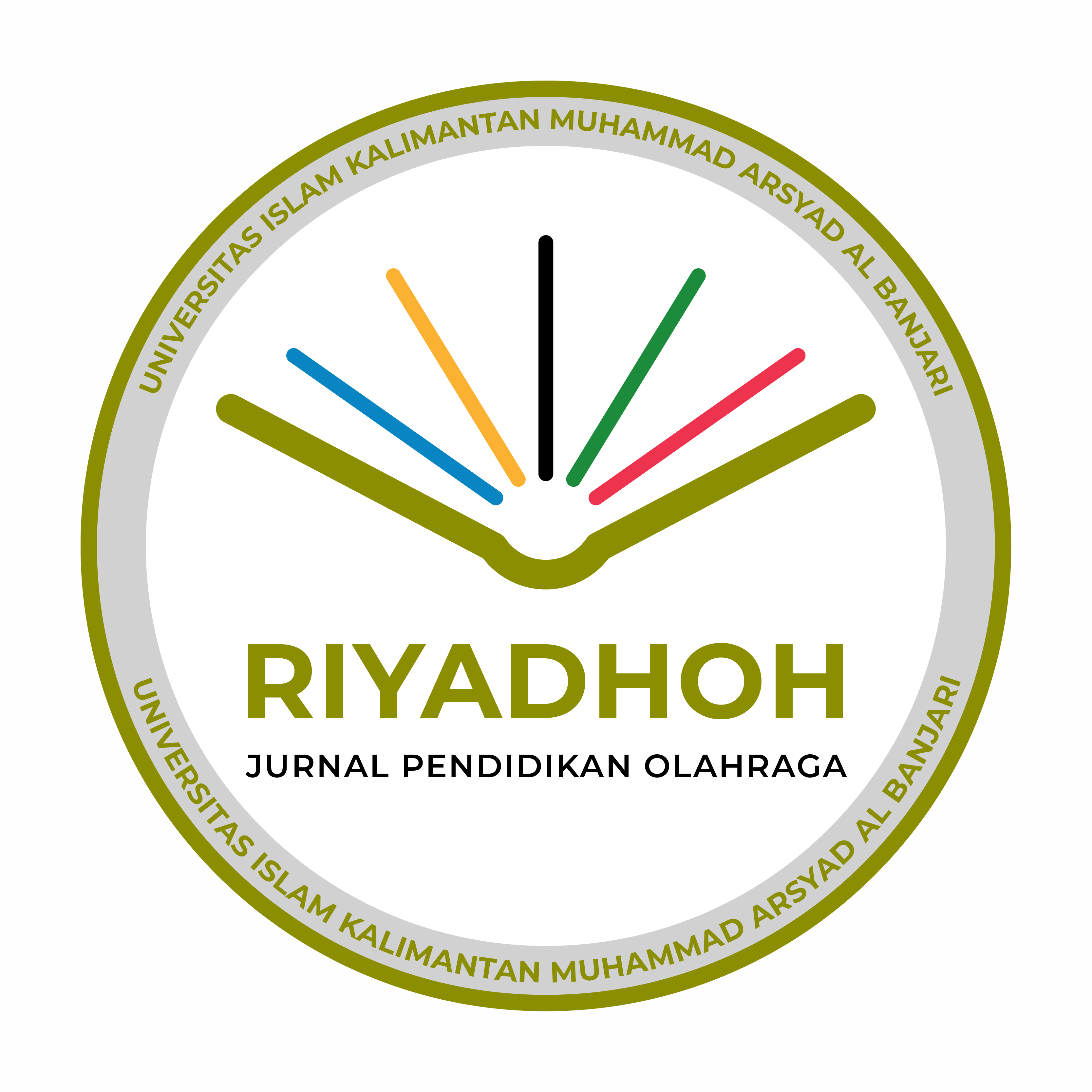PHYSICAL ACTIVITIES OF SOUTH KALIMANTAN PRIMARY SCHOOL STUDENTS OUTSIDE SCHOOL HOURS
(1) Universitas Lambung Mangkurat
(2) Universitas Lambung Mangkurat
(3) Universitas Lambung Mangkurat
(4) Universitas Lambung Mangkurat
(5) Universitas Lambung Mangkurat
(*) Corresponding Author
Sari
The aim of physical education is to develop physical abilities. Good physical abilities have an impact on students' ability to think and concentrate on learning. Children aged 5 to 17 years are recommended to do physical activity with a duration of 60 minutes in the moderate to vigorous intensity category. Physical activity done more than 60 minutes a day can provide body health. Learning PE at school, all the time available for learning is not fully used effectively so that to gain physical fitness students must spend time doing physical activities outside of learning hours. The aim of this research is to determine the physical activity carried out by students outside school hours. The sample for this research was 174 students in elementary schools throughout South Kalimantan. This research uses quantitative descriptive research methods. The technique used in taking samples is purposive sampling. The instrument used to obtain research data was the IPAQ questionnaire. The research results showed that physical activity carried out by students with heavy activities was mostly carried out for 3 days with a percentage of 28%, the time range used was 60-90 minutes a day. Students who do moderate activities mostly do it for 2 days with a percentage of 24%, the time span used is less than 60 minutes a day. Students' walking activities are mostly carried out for 7 days with a percentage of 61%, the time range used is 60-90 minutes a day. Students do most of the sitting activities for 7 days with a percentage of 59%, the time range used is 60-90 minutes a day. Elementary school students do a lot of physical activity in the moderate category with a range of 600 – 6000 MET-minutes/week as much as 51.72%.
Kata Kunci
Teks Lengkap:
PDFReferensi
Adjie Mas Achmad Nur Aulia Arifaen, Harwanto, & Hari Karyono. (2020). Engaruh Waktu Pembelajaran Pendidikan Jasmani Olahraga Dan Kesehatan (Pjok) Terhadap Tingkat Kebugaran Siswa Kelas V Mi Bahrul Ulum Sukodono Sidoarjo. Jurnal Kejaora (Kesehatan Jasmani dan Olah Raga), 5(2), 93–96. https://doi.org/10.36526/kejaora.v5i2.1043
Al Fathan, K. M., Andriani, K. M., Nurjanah, M., Munawaroh, R. Z., & Dewi, D. T. (2022). Analisis Materi Pendidikan Jasmani Olahraga dan Kesehatan (PJOK) untuk Sekolah Dasar. Edukatif : Jurnal Ilmu Pendidikan, 4(5), 6914–6921. https://doi.org/10.31004/edukatif.v4i5.3392
Alfani, W. H. (2022). Problematika Pembelajaran Pendidikan Jasmani Olahraga Dan Kesehatan (PJOK) Secara Hybrid Learning di Mim 06 Al Amin Paciran Lamongan [Universitas Islam Negeri Maulana Malik Ibrahim Malang]. http://etheses.uin-malang.ac.id/38032/1/18140012.pdf
Alghozi, F. Z. (2021). Hubungan antara Aktivitas Fisik dengan Kebugaran Jasmani Peserta Didik Kelas Atas di Sekolah Dasar Negeri Tambakrejo Tempel Kabupaten Sleman [Skripsi, Universitas Negeri Yogyakarta]. http://eprints.uny.ac.id/63640/1/fulltext_faishol%20zulfa%20alghozi_14604221067.pdf
Andiyanto, E., Simanjuntak, V. G., & Haetami, M. (2020). Efektifitas Waktu Belajar Pendidikan Jasmani Olahraga Dan Kesehatan Pada Peserta Didik Sekolah Menengah Atas. Jurnal Pendidikan Dan Pembelajaran Khatulistiwa, 9(1), 1–8.
Budayati, E. S. (2015). Pentingnya Kebugaran Jasmanibagi Guru Profesional. Medikora, 2, 141–150. https://doi.org/10.21831/medikora.v0i2.4679
Gandasari, M. F., & Manurung, J. S. R. (2020). Evaluasi Potensi Fisik Siswa Sma Sebagai Suatu Hasil Belajar Mata Pelajaran Penjasorkes (Studi Pada Sma Negeri Di Kecamatan Sengah Temila). Riyadhoh : Jurnal Pendidikan Olahraga, 3(2), 87. https://doi.org/10.31602/rjpo.v3i2.3577
Gani, A., Ismaya, B., & Dimyati, A. (2021). Survei Minat Siswa dalam Mengikuti Ekstrakurikuler SepakBola Di SMPN 1 Lemahabang Karawang. Riyadhoh : Jurnal Pendidikan Olahraga, 4(2), 47. https://doi.org/10.31602/rjpo.v4i2.5293
Giriwijoyo, S. & Sidik, D.Z. (2013). Ilmu kesehatan olahraga (1st ed.). PT Remaja Rosadakarya.
Hagströmer, M., Oja, P., & Sjöström, M. (2006). The International Physical Activity Questionnaire (IPAQ): A study of concurrent and construct validity. Public Health Nutrition, 9(6), 755–762. https://doi.org/10.1079/PHN2005898
Haryani, M., Nurkhoiroh, N., Suardika, I. K., Haryanto, A. I., & Pulungan, K. A. (2022). Peningkatan Hasil Belajar Pjok Materi Pergaulan Sehat Menggunakan Metode Pembelajaran Pendekatan Saintifik. Riyadhoh : Jurnal Pendidikan Olahraga, 5(2), 71. https://doi.org/10.31602/rjpo.v5i2.8798
Irianto, T. (2014). Implementasi Kurikulum 2013 dalam Pembelajaran Pendidikan Jasmani Olahraga dan Kesehatan di Sekolah Dasar. Jurnal Multilateral, 13(1), 58–61.
Kusmiyati, K., Sejati, R. G., & Ruman, R. (2020). Pengembangan Permainan Sunda Manda Puzzle Untuk Optimalisasi Kemampuan Motorik dan Pembentukan Karakter Cermat dalam Pembelajaran Penjasorkes Di SD. Riyadhoh : Jurnal Pendidikan Olahraga, 3(2), 31. https://doi.org/10.31602/rjpo.v3i2.3719
Kuswandi. (2018). Hubungan Tingkat Kesegaran Jasmani Terhadap Prestasi Belajar Pendidikan Jasmani Siswa Kelas VII SMPN 4 Pinggir Kabupaten Bengkalis. In Skripsi. Universitas Islam Riau.
Mas’an Al Wahid, S., & Prayoga, H. D. (2021). Survei Pengelolaan Ekstrakurikuler Olahraga Sekolah Dasar Negeri Kota Tarakan. Riyadhoh : Jurnal Pendidikan Olahraga, 4(1), 27. https://doi.org/10.31602/rjpo.v4i1.4306
Mendes, M. D. A., Da Silva, I., Ramires, V., Reichert, F., Martins, R., Ferreira, R., & Tomasi, E. (2018). Metabolic equivalent of task (METs) thresholds as an indicator of physical activity intensity. PLOS ONE, 13(7), e0200701. https://doi.org/10.1371/journal.pone.0200701
Nasution, M. C., & Syaleh, M. (2021). Analisis Faktor-Faktor yang Mempengaruhi Hasil Belajar PJOK pada Siswa Kelas V SD Negeri 104259 Citaman Jernih Kecamatan Perbaungan Kabupaten Serdang Bedagai Tahun Ajaran 2020/2021. JOSEPHA: Journal of Sport Science And Physical Education, 2(2), 1–10. https://doi.org/10.38114/josepha.v2i2.156
Sceisarriya, V. M. (2021). Problematika Pelaksanaan Pendidikan Jasmani Di Sekolah Dasar. Profesionalisme Tenaga Profesi PJOK, 1, 153–159. https://core.ac.uk/download/pdf/267024025.pdf
Silitonga, F. A., & Verawati, I. (2019). Hubungan Tingkat Kebugaran Jasmani dengan Prestasi Belajar Siswa Putra Kelas XI SMAN 1 Sihpahutar Tapanuli Utara. Jurnal Kesehatan Dan Olahraga, 3(1), 29–38.
Sucipto, S. (2019). The Implementation of Tactical Approach on Students’ Enjoyment in Playing Football in Junior High School. Jurnal Pendidikan Jasmani Dan Olahraga, 4(1). https://doi.org/10.17509/jpjo.v4i1.16252
Sugiarto, B. G. (2017). Pengaruh Distribusi Alokasi Waktu Dan Motivasi Terhadap Kebugaran Jasmani Siswa Sekolah Dasar. Jurnal Pedagogik Olahraga, 03(01).
Sugiyono. (2016). Metode Penelitian Kuantitatif, Kualitatif dan R &D. Alfabeta.
Sulistyawati, W., & Trinuryono, S. (2022). Analisis (Deskriptif Kuantitatif) Motivasi Belajar Siswa Dengan Model Blended Learning Di Masa Pandemi Covid19.
Wahidmurni. (2017). Pemaparan Metode Penelitian Kuantitatif. UIN Maulana Malik Ibrahim Malang, 1–14.
WHO. (2017). World Health Organization: Global Strategy on Diet, Physical Activity and Health.
Widodo, A. (2018). Makna Dan Peran Pendidikan Jasmani Dalam Pembentukan Insan Yang Melek Jasmaniah/Ter-Literasi Jasmaniahnya. Motion: Jurnal Riset Physical Education, 9(1), 53–60. https://doi.org/10.33558/motion.v9i1.1432
Wijaya, W. H., & Ks, S. (2015). Permainan Bokingan Untuk Pembelajaran Permainan Bola Besar Penjasorkes Sekolah Dasar.
DOI: http://dx.doi.org/10.31602/rjpo.v0i0.11949
Refbacks
- Saat ini tidak ada refbacks.
Index Jurnal :
Didedikasikan Untuk:


Riyadhoh : Jurnal Pendidikan Olahraga disebar luaskan oleh : Lisensi Creative Commons Atribusi 4.0 Internasional.









.jpg)





